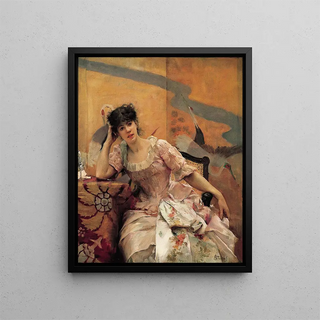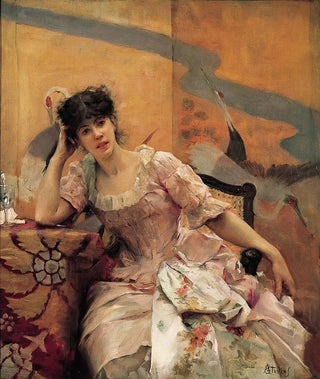Art print | Young woman with a Japanese screen - Alfred Stevens


View from behind

Frame (optional)
In the fascinating world of art, certain works stand out for their ability to capture fleeting moments and transform them into timeless visual stories. "Young Woman with a Japanese Screen" by Alfred Stevens is one of those creations that evoke an atmosphere both delicate and mysterious. This painting, depicting an elegant young woman immersed in a world of beauty and refinement, invites us to explore the subtleties of daily life in the 19th century. The piece, through its meticulous aesthetic, immerses us in a universe where fashion, culture, and art intersect, revealing the nuances of a rapidly changing era.
Style and uniqueness of the work
Alfred Stevens' style is characterized by exceptional attention to detail and mastery of colors that make the canvas vibrate. In "Young Woman with a Japanese Screen," light plays a crucial role, illuminating the protagonist's face while creating delicate shadows that add depth to the composition. The Japanese screen, a symbol of exoticism and intimacy, is skillfully integrated into the scene, highlighting not only the beauty of the young woman but also the growing influence of the Orient on Western art. Floral motifs and delicate textures of the screen complement the elegance of the young woman's dress, demonstrating refined taste and aesthetic sensitivity that define Stevens' work. This piece is a true tableau of bourgeois life, combining sophistication and simplicity, and transports us to a suspended moment where every detail matters.
The artist and his influence
Alfred Stevens, a Belgian painter of the 19th century, is often regarded as one of the masters of the female portrait genre. His career, marked by diverse influences ranging from realism to Impressionism, allowed him to develop a unique style that continues to inspire many contemporary artists. Stevens was able to capture the essence of femininity through his works, revealing the complexity of emotions and human relationships. His interest in themes of fashion and beauty, as well as his penchant for exoticism, are key elements found in "Young Woman with a Japanese Screen."

Matte finish

View from behind

Frame (optional)
In the fascinating world of art, certain works stand out for their ability to capture fleeting moments and transform them into timeless visual stories. "Young Woman with a Japanese Screen" by Alfred Stevens is one of those creations that evoke an atmosphere both delicate and mysterious. This painting, depicting an elegant young woman immersed in a world of beauty and refinement, invites us to explore the subtleties of daily life in the 19th century. The piece, through its meticulous aesthetic, immerses us in a universe where fashion, culture, and art intersect, revealing the nuances of a rapidly changing era.
Style and uniqueness of the work
Alfred Stevens' style is characterized by exceptional attention to detail and mastery of colors that make the canvas vibrate. In "Young Woman with a Japanese Screen," light plays a crucial role, illuminating the protagonist's face while creating delicate shadows that add depth to the composition. The Japanese screen, a symbol of exoticism and intimacy, is skillfully integrated into the scene, highlighting not only the beauty of the young woman but also the growing influence of the Orient on Western art. Floral motifs and delicate textures of the screen complement the elegance of the young woman's dress, demonstrating refined taste and aesthetic sensitivity that define Stevens' work. This piece is a true tableau of bourgeois life, combining sophistication and simplicity, and transports us to a suspended moment where every detail matters.
The artist and his influence
Alfred Stevens, a Belgian painter of the 19th century, is often regarded as one of the masters of the female portrait genre. His career, marked by diverse influences ranging from realism to Impressionism, allowed him to develop a unique style that continues to inspire many contemporary artists. Stevens was able to capture the essence of femininity through his works, revealing the complexity of emotions and human relationships. His interest in themes of fashion and beauty, as well as his penchant for exoticism, are key elements found in "Young Woman with a Japanese Screen."






